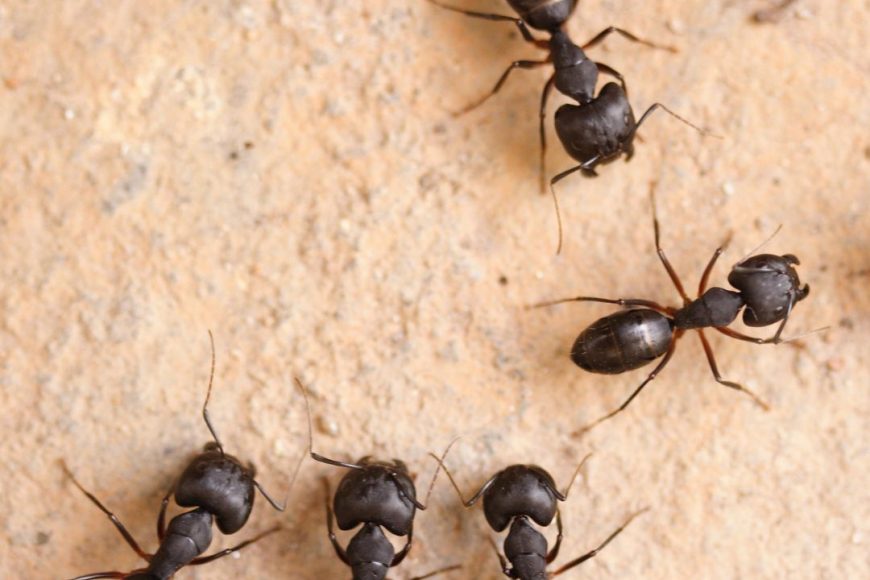Fill out the form below and a Cypress Creek representative will be in touch with you about your pest control needs.
BLOG

Your Guide to Common Ants in Houston
Few things are more Texan than a summer picnic, but few things can ruin one faster than a swarm of ants. If you’ve found a line of these tiny invaders marching across your kitchen counter or setting up camp in your pantry, you’re not alone. Houston’s warm, humid climate is a paradise for numerous ant species, making them one of the most common household pests in the area.
Understanding what type of ant you’re dealing with is the first step toward reclaiming your space. This guide will walk you through the most common ants found in the Houston area, from the frustratingly erratic rover ants to the infamous fire ants. We’ll explain how to identify them, what attracts them, and most importantly, how to get them out of your home for good.
Why Are Ants So Common in Houston?
Houston provides the perfect environment for ants to thrive. The combination of heat, high humidity, and frequent rainfall creates ideal living conditions. Ants are constantly searching for three things: food, water, and shelter. Our homes and businesses offer a reliable supply of all three, especially during extreme weather conditions like heavy rain or intense summer heat, which drive them indoors.
While some ants are just a nuisance, others can cause significant problems. Certain species can contaminate food, damage property, and even deliver painful stings. Identifying the specific ant species is crucial because different types require different treatment methods.
Common Ants in the Houston Area
Let’s look at some of the uninvited guests you might find in your Houston home or yard. The information below is based on the scraped page content from cycreekpestcontrol.com.
Rover Ants
These tiny, dark brown or black ants are a major nuisance in Houston. Rover ants are often found in moist areas like bathrooms, kitchens, and around potted plants. They move in an erratic, jerky manner, which can make them difficult to track. While they don’t bite or sting, their sheer numbers can be overwhelming as they quickly establish large colonies.
Ghost Ants
Named for their pale, almost translucent legs and abdomen, ghost ants are tiny and hard to spot. They have a sweet tooth and are often found trailing along kitchen countertops or baseboards in search of sugary spills. Like rover ants, they are drawn to moisture and are common in kitchens and bathrooms. Their small size allows them to nest in tiny spaces, like behind baseboards or in wall voids.
Tawny (Rasberry) Crazy Ants
If you see ants running around in a frantic, unpredictable pattern, you might have Tawny crazy ants. These reddish-brown ants get their name from their chaotic movements. They don’t form neat trails like other ants. Crazy ants are known for their attraction to electrical equipment, where they can cause short circuits and damage to appliances, air conditioning units, and other electronics.
Argentine Ants
Argentine ants are light to dark brown and are known for forming massive colonies with multiple queens. They create wide, well-defined trails and are often seen marching up the sides of buildings. These ants are highly adaptable and will eat almost anything, though they prefer sweets. When crushed, they emit a musty odor. Their large numbers can quickly overwhelm a property.
Acrobat Ants
Acrobat ants get their name from their habit of raising their heart-shaped abdomen over their head when disturbed, resembling a circus acrobat. They are typically light brown to black and often nest in moist, decaying wood. You might find them in window frames, doorframes, or areas with water damage. While they primarily nest outdoors, they will forage for food inside your home.
Pyramid Ants
These small ants build distinctive, cone-shaped mounds in open, sunny areas of your lawn, which gives them their name. Pyramid ants are not typically found inside homes, as they prefer to nest outdoors. They are generally not aggressive and are considered more of a lawn pest than a household one.
Bigheaded Ants
As their name suggests, bigheaded ants have workers of two sizes: major workers with very large heads and minor workers with normal-sized heads. The major workers use their powerful jaws to crack open seeds. These ants are reddish-brown and often nest in the soil, creating noticeable mounds. They can forage indoors for food, particularly proteins and grease.
Little Black Ants
These tiny, jet-black ants are a common sight in Houston homes. They are opportunistic feeders and will eat everything from sweets and meats to grease and vegetables. Little black ants often nest in woodwork, wall voids, and behind masonry. While their colonies are smaller than those of other species, they can still become a persistent problem once they get inside.
Your Partner in Pest Control
Dealing with an ant infestation on your own can be a frustrating and often unsuccessful battle. Over-the-counter sprays and baits may kill the ants you see, but they rarely eliminate the entire colony, including the queen. For a solution that lasts, you need a professional approach.
At Cypress Creek Pest Control, we have been protecting Houston homes and businesses from pests since 1968. With service to over 12,000 properties, our experienced technicians have the knowledge and tools to handle any ant problem, big or small. We don’t just treat the symptoms; we identify the source of the infestation and create a tailored plan to eliminate it for good.
Our comprehensive pest control service includes:
- Thorough Inspection: We identify the ant species and locate their nests.
- Targeted Treatment: We use the right products and methods for your specific ant problem, treating key areas inside and outside your home.
- Preventative Measures: Our Healthy House Program offers quarterly treatments to keep your home pest-free all year round.
Don’t let ants take over your Houston home. Take the first step toward a pest-free property by scheduling a free estimate with our team today.

